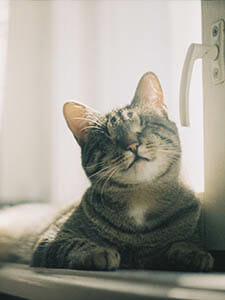Pre-Existing Conditions
Find out what it means when your pet has a pre-existing condition, when and why they are eligible for review and how to apply to have a pre-existing exclusion lifted from your policy.
What is a pre-existing condition?
A pre-existing condition is:
- A condition that existed or occurred prior to the commencement date of your first policy period or within any applicable waiting period.
- A condition that you or your vet were aware of, or a reasonable person in your circumstances would have been aware of.
This is irrespective of whether the underlying or causative condition was diagnosed at the time.
Does pet insurance cover pre-existing conditions?
Similar to other forms of insurance, anything that existed or that you were aware of before your pet was insured is generally excluded from cover. Insurance policies are there to protect against the unexpected so for this reason, claims relating to pre-existing conditions are not covered. This helps keep coverage fair for all of our customers.
However, we know that some conditions can genuinely be resolved or cured. So for that reason, pre-existing conditions are assessed differently depending on whether they are chronic conditions or temporary conditions for your pet.
What is a temporary condition?
A temporary condition is a condition, which normally resolves with treatment, other than:
- Cruciate ligament conditions
- Intervertebral disc disease (IVDD)
- Hip dysplasia
- Elbow dysplasia
- Patella luxation
- Endocrine diseases
- Any other chronic condition
If your pet has a temporary condition which has not existed, occurred or shown noticeable signs, symptoms or an abnormality in the 18-month period prior to your claim treatment date, it will no longer be excluded from your policy as a pre-existing condition. Chronic conditions and several other specified conditions will not be categorised as a temporary condition and will always be excluded from cover.

EXAMPLES OF PRE-EXISTING TEMPORARY CONDITIONS

1. You have specified accidental injury and illness cover. For example: Your pet has dietary related gastroenteritis prior to the commencement date of your first policy period. This is resolved with medication. Your pet does not suffer any further instances of dietary related gastroenteritis until three years later.
This condition would be a temporary condition that has not existed, occurred or shown noticeable signs, symptoms or an abnormality in the 18-month period immediately prior to the second gastroenteritis episode. It would not be a pre-existing condition and therefore would be covered, subject to your policy terms and conditions.
Refer to your PDS and certificate of insurance for further information.
Your claim would be eligible for benefits because:
- The first gastroenteritis episode was a temporary condition, given that it normally resolves with treatment that was treated and is not on the list of excluded conditions for temporary conditions (refer to the question ‘what is a temporary condition’ and the PDS).
- There was more than an 18-month gap between the conditions.
- The second episode of gastroenteritis was not a related condition. See ‘What is a related condition?’ and the PDS.
- The condition was not specifically excluded in the PDS.
Note: Examples above are of a general nature and you should refer to your Product Disclosure Statement and Certificate of Insurance for information about conditions covered under your policy.
What is a chronic condition?
A chronic condition is long-lasting or recurring in its effects and affects (or is present in) a pet over a period greater than three months in total. The three-month period does not need to be consecutive.
Chronic conditions may also be intermittent or managed with medication and/or prescription diets with intervals of remission. If your pet has a chronic condition that occurred or existed prior to the commencement date of the first policy period or during any applicable waiting period, it will always be excluded from your policy as a pre-existing condition.
EXAMPLES OF PRE-EXISTING CHRONIC CONDITIONS

1. Your pet is limping and is diagnosed with a grade two luxating patella (dislocating kneecap) within the applicable waiting period of the policy. Your vet prescribes anti-inflammatory medication. This claim is not covered, because you and your vet became aware of the condition within the 30-day waiting period for this condition.
Two years later, your pet requires surgery for the patella luxation. This condition is excluded from cover because:
- You and your vet first became aware of the condition in the applicable waiting period.
- The condition (patella luxation) is not a temporary condition, as it is specifically excluded from that definition.
- As a result, it remains a pre-existing condition two years later.



2. Your pet has had recurring seasonal allergies every spring and summer since it was two-months old. This recurs for a period greater than three months. You purchase a pet insurance policy and two years later make a claim for another round of allergy treatment.
Your claim would not be eligible for benefits and excluded from cover because:
- The condition is a pre-existing condition, given that you were aware of it prior to commencement of your first policy period.
- Your pet’s seasonal allergy condition is not a temporary condition, as it is specifically excluded as a chronic condition. This is because it was long-lasting, recurring and affected your pet for a period greater than three months.
- As a result, it remains a pre-existing condition two years later.
Note: Examples above are of a general nature and you should refer to your Product Disclosure Statement and Certificate of Insurance for information about conditions covered under your policy.
What is a related condition?
A related condition is something that results from the same disease process, arises as a consequence of or has the same diagnostic classification as another condition. This is regardless of the number of areas of your pet’s body that are affected.
For example:
1. If your pet suffers from arthritis in its legs, all future occurrences of arthritis (e.g. in the back or neck) will be related conditions.
2. If your pet suffers from diabetes and then develops a cataract as a consequence of the diabetes, the cataract will then be a related condition.
3. If your pet suffers from a skin hotspot, then later suffers from ringworm on its skin, these are not related conditions, as the ringworm is not as a consequence of the hotspot, nor do they follow the same disease process or diagnostic classification.
How do I apply to have a pre-existing condition reviewed?
If your pet has had a temporary condition that was subject to the pre-existing condition exclusion, it will no longer be excluded from your policy as a pre-existing condition. When you submit a claim we will automatically review it for you, but you can also apply to have it reviewed.
Your vet will need to certify and provide veterinary records verifying that the condition remains a temporary condition and has not existed, occurred or shown noticeable signs, symptoms or an abnormality for a period of 18 months. The pre-existing condition exclusion(s) will not be deemed to have been lifted unless agreed to by us in writing.
You can download a copy of the Pre-existing Condition Review form here.
If your pet has a chronic condition that existed or occurred before the commencement date of your first policy period or during any applicable waiting period, that condition will always be excluded from your policy.
To find out more information about pre-existing conditions and how they apply to your cover, please ensure you review the relevant Product Disclosure Statement and Certificate of Insurance.

Nadia Crighton is a renowned and accomplished professional in the fields of Journalism, Public Relations, and Writing, with an extensive career spanning over 25 years, 20 of which have been dedicated to promoting the health and well-being of pets.
